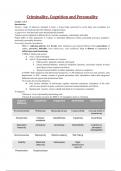Criminality, Cognition and Personality
Lecture 1 ch 1
Introduction
Violence: range of behaviors intended to harm a living being motivated to avoid harm (not accidental, not
consensual, not beneficial) forceful infliction of physical harm
vs aggression: less physically more psychologically harmful
Violence can be explained at different levels: societal, community, relationship, individual
People differ in their propension to violence to individual differences (traits), personality processes (cognitive,
emotional), personality disorders:
Personality disorders described in
- DSM 5: enduring patterns that deviate inner experience and outward behavior from expectations of
culture, pervasive, inflexible, onset adolescence, early adulthood, leads to distress or impairment in
self/interpersonal functioning.
X DSM-4: Multi-axial system:
A. Axis I: clinical disorders
B. Axis II: 10 personality disorders in 3 clusters:
a. Odd/eccentric: paranoid, schizoid, schizotypal
b. Erratic-Dramatic/flamboy: antisocial, borderline, histrionic, narcissistic (cluster 10 times
more likely to have criminal conviction)
c. Worried-Anxious/fearful: avoidant, dependent, obsessive-compulsive
In DSM-5 both categorical and dimensional perspective, to PD multiaxial system not used anymore, only
dimensional, so PD= extreme variants of general personality traits, Quantitative rather than categorical
difference between typical and dysfunctional traits
Personality functioning defined as:
● Self: identity (stability of self-esteem, regulate emotional experience, boundaries of the self),
self-direction (pursuit of goals, constructive prosocial internal standards, self-reflect)
● Interpersonal: empathy, intimacy (depth and duration of connections, mutuality)
To diagnose:
- Criterion A: level of personality functioning scale
- Criterion B: personality inventory for DSM-5: 25 maladaptive traits in 5 domains
,Combining these traits we get only 6 PD, the rest (paranoid, schizoid, histrionic, dependent) not recognised anymore
in the new version.
- ICD-10 (international classification of diseases): enduring patterns, inflexible, extreme deviation from
culture, frequently, not always associated with distress
Study: in the UK men have more personality disorders (m5.4%, F3.4%), personality disorder offenders have more
recidivism, seriousness, reconviction (more aggression to antisocial PD because of circularity of the definition vs
inhibition is protective), cluster B=elevation criminal risk, but still the majority don't commit.
!! only adult can be diagnosed with PD
X Nestor 4 personality dimensions as risk factors to violence: impulse control, affect regulation, narcissism,
paranoid cognitive personality style.
Personality disorder to not legally give mitigation of culpability as other mental illnesses, mitigated if impairment in
Rational decisions, control behavior, awareness of harm: es. Learning disabilities, intellectual disability, dementia
unlikely to be punished
Antisocial PD: knowing the consequences but unable to exercise control over actions, still responsible=
proportionate punishment (but works if immediate, inevitable, person understands the lunk and can help change in
attitude)
Life-course Developmental path: Interactions of biological, psychological, social, contextual variables
➔ Early impulsivity, childhood conduct problems, deficit executive functions, planning, attention,
abstract reasoning, behavioral inhibition
, ➔ Harsh inconsistent parenting, desensitized to punishment, conflict/antisocial behavior in family,
deviant peers, school truancy
➔ In boys low (MAOA) monoamine oxidase A enzyme activity (low metabolism neurotransmitters)
if + maltreatment= greater risk
= poorly educated adult, with convictions, drinking/drug problem, no work, uses violence to solve
problems
Treatment targets: family support, parent training, school inclusion, problem solving, emotion control,
antisocial biases, attitudes.
VS Psychopathy: because of lack of emotional capacities do not even understand the consequences of their actions,
the individual does not learn from punishment (just to safety/disapproval society)
Developmental path:
➔ Children with callous, unemotional traits, use instrumental and reactive aggression, indifference to
punishment and others distress, low socialization, lack flexibility to changing situation (always same
response so frustration if doesnt work)
➔ Deficit amygdala, orbital/ventrolateral frontal cortex= fear, empathy deficit
= not good early attachments , prosocial models can help but more difficult
Psychological evaluation of a violent person: Considerations to keep in mind
1. Psychopathology: Degree of choice in the use of violence (in a strictly legal model): es if there is no moral
conflict, loss of control or distress, this was the Dominant model for a long time
2. Formal model of reference and evaluation: (psychiatric/psychological model)
- Personality problems: do they meet PD criteria? Disadvantages of categorical model because if at
the limit they are not treated or recognised
- Individual’s traits, history, thoughts and feelings – Dimensional model
Punishment does not reduce crime, treatment works best (CBT 30% reduction in adult, 60% in young): PD offenders
managed by both criminal justice & forensic mental health setting (punishment + treatment)
BUT Not all offenders with PDs are equally treatable= Appropriate treatment targets need to be identified
● Intermittent explosive disorder or Borderline PD: Violence driven by strong emotions (anger), Inability to
control behavior= Emotional dysregulation, need more self-control= can be treated
● Vs Psychopathy: Violence driven by possible gains, Control over others + material benefits= treatment
rejecting
Treatments: Ideally to degree of dysfunctioning= punishment and treatment, in reality not available many services to
PDs: CBT & psychodynamic therapy: good effects for PDs in general but Limited good quality research
+ mainly BPD (in general) BUT offenders with PDs are not representative of all PD patients
+ Antisocial PD treatment? Only a few studies! (very narrow treatment)
+ Psychopathy treatability? 24 studies, but methodologically poor
Lecture 2 ch 2,3
Predictors and explanations
The functional link between personality disorder and violence:
In England created services to DSPD= dangerous because of their severe personality disorder, they can be subjected
to compulsory treatment in a special unit, to have scientific basis in court decisions. But need to fall under:
1. Severe personality disorder: Classified as severe if:
a. Sufficient degree of psychopathic traits (30)
b. High psychopathic score (25-29) + PD that is not antisocial
c. 2 or more PDs no matter PCL-R score (because even if not psychopathic they could be dangerous,
bit some PD are less associated with violence then others (dependent, avoidant)
2. Likely to be violent in the next 5 years (based on risk assessment)




